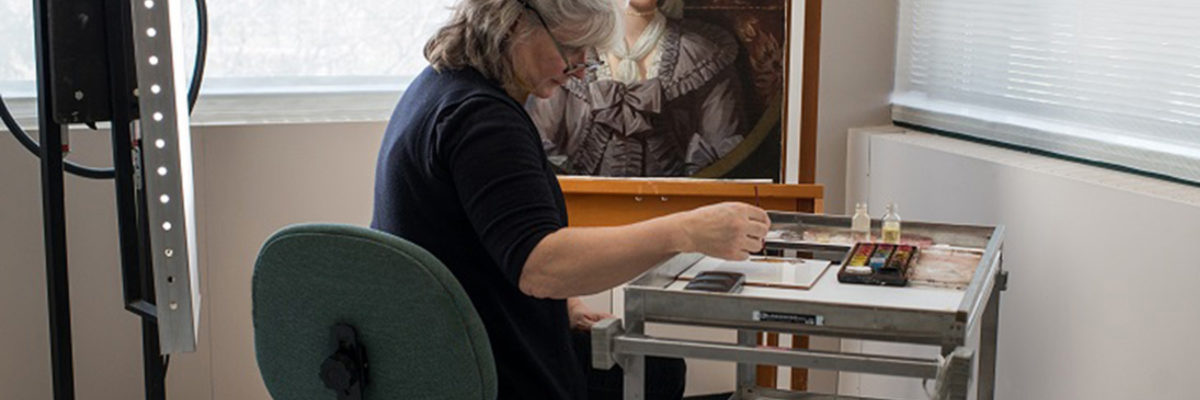
#AskAConservator: How to unroll curled photos?
CAPC is participating in #AskAConservator Day! Christi from The Canadian Baseball Hall of Fame and Museum asks: We have received a donation of photographs to our archival collection. These photographs had previously been rolled up and have now become tightly curled. How do you recommend best unrolling/flattening these photographs and storing them, with limited conservation resources? We do not have the ability to add humidity, for example.
Jennifer Robertson answers:
Thank you for asking about this and thanks for participating in #AskAConservator day! Rolled photographs are very common, but of course are difficult to store in that condition and ideally should be unrolled for flat storage.
If you are able to open them gently without causing any cracking, do so carefully and place them between several sheets of clean, dry blotter paper, and then under boards or glass, and weights. Letting them sit flat under weight for several weeks or longer may help them adjust to being open enough for you to keep them flat in a storage folder.
However, if the photographs are extremely brittle, you may find it impossible to unroll them without causing damage. In that case, if you feel comfortable doing so, it can be very easy to construct a small humidity chamber to help relax the paper enough to safely open them.
There are some cautions I’d like you to be aware of, however. I would not recommend this treatment if there is any ink writing on the items, as moisture can cause iron gall ink corrosion, or bleeding of some other types of inks. And the same in the case of any metal attachments, like staples or paperclips, or post-it notes. Also, if the items appear soiled (I know it may be hard to tell if they are rolled, but try to judge the best you can), it may be best to leave them as is - the surface soiling can be more difficult to remove after humidification, and may stick to the humidified gelatin photograph surface.
But if after a close assessment, you feel it is safe to proceed, you can make a small and simple humidity chamber using a clear plastic storage bin, some plastic egg-crate grid sheets, and blotter paper or paper towel. The moisture from the wet blotter at the bottom will raise the humidity in a small space like a storage bin enough to help the paper relax, and you don’t need any special equipment.
Start with a clear bin large enough to hold the rolled photographs (either one at a time, or several, depending on size). Cut 2 pieces of the egg-crate plastic grid to the size of the bin - if the bin is a bit shaped or tapered at the bottom, even better - try to get the egg-crate sheet to rest a few inches up from the bottom. You can also use plastic cups or blocks to keep it up a few inches. Dampen the blotter paper or several sheets of paper towel until it is wet but not dripping, and lay it flat in the bottom, then place the blocks and egg-crate on top. You want there to be a good few inches between the wet material and the egg-crate, so there’s no chance of your photographs touching anything wet.
Place the artifacts on the egg-crate sheet, making sure they aren’t touching the walls of the bin (and make sure it is dry all over except the blotter at the bottom). Put the lid on and let the photographs humidify for 10 minutes, and then check on them. Depending on the materials, you could have enough humidification to unroll them after 10 minutes, or it could take up to an hour, but I recommend checking on them every 10 or 15 minutes. Just gently try to unroll and see how much resistance you feel. If it feels like they are giving way enough to safely unroll them without any cracking, then take them out, lay them on clean blotter paper, and unroll them.
If you have any fine Hollytex fabric, place the items between two sheets of it, and then between at least two sheets of dry blotter on either side. If you don’t have Hollytex, placing them between the blotter alone should be fine, as long as there is no adhesive on the photographs. Place the stack under boards or glass and weight them to dry. It’s best to change the blotter several times during the first day, and then once or twice a day over the next week, and keep the weights on.
This should help the photographs to flatten enough for you to put them in storage. You can repeat the process several times if necessary, and the longer you keep them under weight, the more likely they will keep their new shape.
When storing them, make sure you are using storage materials (for example folders or tissue) that meet Photographic Activity Test (PAT) standards. Photographs can be sensitive to alkalinity in ways that other archival documents are not, so it’s best to source storage materials that are specifically made for photographic artifacts.
I hope this advice helps. If you have any further questions feel free to contact me directly.
